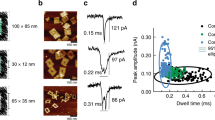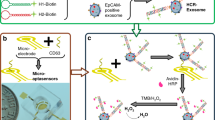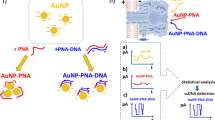Abstract
The occurrence and prognosis of many complex diseases, such as cancers, is associated with the variation of various molecules, including DNA at the genetic level, RNA at the regulatory level, proteins at the functional level and small molecules at the metabolic level (defined collectively as multilevel molecules). Thus it is highly desirable to develop a single platform for detecting multilevel biomarkers for early-stage diagnosis. Here we report a protocol on DNA-nanostructure-based programmable engineering of the biomolecular recognition interface, which provides a universal electrochemical biosensing platform for the ultrasensitive detection of nucleic acids (DNA/RNA), proteins, small molecules and whole cells. The protocol starts with the synthesis of a series of differentially sized, self-assembled tetrahedral DNA nanostructures (TDNs) with site-specifically modified thiol groups that can be readily anchored on the surface of a gold electrode with high reproducibility. By exploiting the rigid structure, nanoscale addressability and versatile functionality of TDNs, one can tailor the type of biomolecular probes appended on individual TDNs for the detection of specific molecules of interest. Target binding occurring on the gold surface patterned with TDNs is quantitatively translated into electrochemical signals via a coupled enzyme-based catalytic process. This uses a sandwich assay strategy in which biotinylated reporter probes recognize TDN-bound target biomolecules, which then allow binding of horseradish-peroxidase-conjugated avidin (avidin–HRP). Hydrogen peroxide (H2O2) is then reduced by avidin–HRP in the presence of TMB (3,3′,5,5′-tetramethylbenzidine) to generate a quantitative electrochemical signal. The time range for the entire protocol is ∼1 d, whereas the detection process takes ∼30 min to 3 h.
This is a preview of subscription content, access via your institution
Access options
Subscribe to this journal
Receive 12 print issues and online access
$259.00 per year
only $21.58 per issue
Buy this article
- Purchase on Springer Link
- Instant access to full article PDF
Prices may be subject to local taxes which are calculated during checkout







Similar content being viewed by others
References
Bonventre, J.V., Vaidya, V.S., Schmouder, R., Feig, P. & Dieterle, F. Next-generation biomarkers for detecting kidney toxicity. Nat. Biotechnol. 28, 436–440 (2010).
Etzioni, R. et al. The case for early detection. Nat. Rev. Cancer 3, 243–252 (2003).
Ferrari, M. Cancer nanotechnology: opportunities and challenges. Nat. Rev. Cancer 5, 161–171 (2005).
Sawyers, C.L. The cancer biomarker problem. Nature 452, 548–552 (2008).
Das, J. et al. An electrochemical clamp assay for direct, rapid analysis of circulating nucleic acids in serum. Nat. Chem. 7, 569–575 (2015).
Fredriksson, S. et al. Multiplexed protein detection by proximity ligation for cancer biomarker validation. Nat. Methods 4, 327–329 (2007).
Kelley, S.O. et al. Advancing the speed, sensitivity and accuracy of biomolecular detection using multi-length-scale engineering. Nat. Nanotechnol. 9, 969–980 (2014).
Kohannim, O. et al. Boosting power for clinical trials using classifiers based on multiple biomarkers. Neurobiol. Aging 31, 1429–1442 (2010).
Mitchell, P.S. et al. Circulating microRNAs as stable blood-based markers for cancer detection. Proc. Natl. Acad. Sci. USA 105, 10513–10518 (2008).
Osterfeld, S.J. et al. Multiplex protein assays based on real-time magnetic nanotag sensing. Proc. Natl. Acad. Sci. USA 105, 20637–20640 (2008).
Sreekumar, A. et al. Metabolomic profiles delineate potential role for sarcosine in prostate cancer progression. Nature 457, 910–914 (2009).
Urdea, M. et al. Requirements for high impact diagnostics in the developing world. Nature 444, 73–79 (2006).
Wang, T.J. et al. Multiple biomarkers for the prediction of first major cardiovascular events and death. New Engl. J. Med. 355, 2631–2639 (2006).
Zethelius, B. et al. Use of multiple biomarkers to improve the prediction of death from cardiovascular causes. New Engl. J. Med. 358, 2107–2116 (2008).
Zheng, G.F., Patolsky, F., Cui, Y., Wang, W.U. & Lieber, C.M. Multiplexed electrical detection of cancer markers with nanowire sensor arrays. Nat. Biotechnol. 23, 1294–1301 (2005).
Das, J. et al. An ultrasensitive universal detector based on neutralizer displacement. Nat. Chem. 4, 642–648 (2012).
Xia, F. et al. Colorimetric detection of DNA, small molecules, proteins, and ions using unmodified gold nanoparticles and conjugated polyelectrolytes. Proc. Natl. Acad. Sci. USA 107, 10837–10841 (2010).
Xiang, Y. & Lu, Y. Using personal glucose meters and functional DNA sensors to quantify a variety of analytical targets. Nat. Chem. 3, 697–703 (2011).
Pei, H. et al. A DNA nanostructure-based biomolecular probe carrier platform for electrochemical biosensing. Adv. Mater. 22, 4754–4758 (2010).
Lin, M.H. et al. Programmable engineering of a biosensing interface with tetrahedral DNA nanostructures for ultrasensitive DNA detection. Angew. Chem. Int. Edit. 54, 2151–2155 (2015).
Chen, X.Q. et al. Ultrasensitive electrochemical detection of prostate-specific antigen by using antibodies anchored on a DNA nanostructural scaffold. Anal. Chem. 86, 7337–7342 (2014).
Ge, Z.L. et al. Hybridization chain reaction amplification of microRNA detection with a tetrahedral DNA nanostructure-based electrochemical biosensor. Anal. Chem. 86, 2124–2130 (2014).
Lin, M.H. et al. Target-responsive, DNA nanostructure-based E-DNA sensor for microRNA analysis. Anal. Chem. 86, 2285–2288 (2014).
Wen, Y.L. et al. DNA nanostructure-based interfacial engineering for PCR-free ultrasensitive electrochemical analysis of microRNA. Sci. Rep. 2 (2012).
Wen, Y.L. et al. DNA nanostructure-decorated surfaces for enhanced aptamer-target binding and electrochemical cocaine sensors. Anal. Chem. 83, 7418–7423 (2011).
Zhou, G.B. et al. Multivalent capture and detection of cancer cells with DNA nanostructured biosensors and multibranched hybridization chain reaction amplification. Anal. Chem. 86, 7843–7848 (2014).
Ge, Z.L., Pei, H., Wang, L.H., Song, S.P. & Fan, C.H. Electrochemical single nucleotide polymorphisms genotyping on surface immobilized three-dimensional branched DNA nanostructure. Sci. China Chem. 54, 1273–1276 (2011).
Wu, J., Campuzano, S., Halford, C., Haake, D.A. & Wang, J. Ternary surface monolayers for ultrasensitive (zeptomole) amperometric detection of nucleic acid hybridization without signal amplification. Anal. Chem. 82, 8830–8837 (2010).
Soleymani, L., Fang, Z.C., Sargent, E.H. & Kelley, S.O. Programming the detection limits of biosensors through controlled nanostructuring. Nat. Nanotechnol. 4, 844–848 (2009).
Yang, F. et al. A bubble-mediated intelligent microscale electrochemical device for single-step quantitative bioassays. Adv. Mater. 26, 4671–4676 (2014).
Deng, W.P. et al. Diagnosis of schistosomiasis japonica with interfacial co-assembly-based multi-channel electrochemical immunosensor arrays. Sci. Rep. 3 1789 (2013).
Zuo, X.L., Xiao, Y. & Plaxco, K.W. High specificity, electrochemical sandwich assays based on single aptamer sequences and suitable for the direct detection of small-molecule targets in blood and other complex matrices. J. Am. Chem. Soc. 131, 6944–6945 (2009).
Zhang, J., Song, S.P., Wang, L.H., Pan, D. & Fan, C.H. A gold nanoparticle-basedchronocoulometric DNA sensor for amplified detection of DNA. Nat. Protoc. 2, 2888–2895 (2007).
Xiao, Y., Lai, R.Y. & Plaxco, K.W. Preparation of electrode-immobilized, redox-modified oligonucleotides for electrochemical DNA and aptamer-based sensing. Nat. Protoc. 2, 2875–2880 (2007).
Steel, A.B., Herne, T.M. & Tarlov, M.J. Electrochemical quantitation of DNA immobilized on gold. Anal. Chem. 70, 4670–4677 (1998).
Acknowledgements
This work was supported by the National Basic Research Program (973 Program grants 2012CB932600, 2013CB933802 and 2013CB932803), NSFC (21422508, 31470960, 21390414, 21227804, 91123037 and 21329501) and the Chinese Academy of Sciences. A.A. extends his sincere appreciation to the Deanship of Scientific Research at King Saud University and the Distinguished Scientist Fellowship Program of King Saud University (RG-1436-005).
Author information
Authors and Affiliations
Contributions
X.Z. and C.F. conceived the projects; M.L., P.S., G.Z., X.L., X.Z. and C.F. designed and conducted the experiments; M.L., A.A., X.Z., J.S., X.L. and C.F. analyzed the data; and M.L., X.Z. and C.F. wrote the manuscript.
Corresponding author
Ethics declarations
Competing interests
The authors declare no competing financial interests.
Rights and permissions
About this article
Cite this article
Lin, M., Song, P., Zhou, G. et al. Electrochemical detection of nucleic acids, proteins, small molecules and cells using a DNA-nanostructure-based universal biosensing platform. Nat Protoc 11, 1244–1263 (2016). https://doi.org/10.1038/nprot.2016.071
Published:
Issue Date:
DOI: https://doi.org/10.1038/nprot.2016.071
This article is cited by
-
Polydopamine-assisted aptamer-carrying tetrahedral DNA microelectrode sensor for ultrasensitive electrochemical detection of exosomes
Journal of Nanobiotechnology (2024)
-
Functionalized tetrahedral DNA frameworks for the capture of circulating tumor cells
Nature Protocols (2024)
-
An impedance labeling free electrochemical aptamer sensor based on tetrahedral DNA nanostructures for doxorubicin determination
Microchimica Acta (2024)
-
A dynamic DNA tetrahedron framework for active targeting
Nature Protocols (2023)
-
Microfluidic magnetic detection system combined with a DNA framework-mediated immune-sandwich assay for rapid and sensitive detection of tumor-derived exosomes
Microsystems & Nanoengineering (2023)
Comments
By submitting a comment you agree to abide by our Terms and Community Guidelines. If you find something abusive or that does not comply with our terms or guidelines please flag it as inappropriate.



